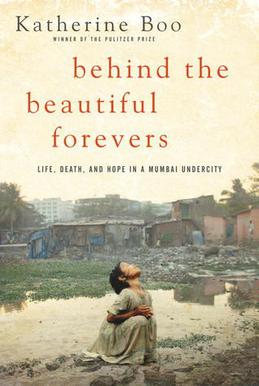Top Qs
Timeline
Chat
Perspective
Behind the Beautiful Forevers
2012 non-fiction book by Katherine Boo about life in a Mumbai slum From Wikipedia, the free encyclopedia
Remove ads
Behind the Beautiful Forevers: Life, Death, and Hope in a Mumbai Undercity is a 2012 non-fiction book by Katherine Boo. The book chronicles the lives of residents in Annawadi, a slum near the Mumbai airport, offering an intimate portrait of poverty, inequality, and resilience in modern India. Drawing from three years of immersive reporting, Boo explores the impacts of globalization, corruption, and social dynamics through the stories of several families. Behind the Beautiful Forevers received widespread critical acclaim and won the National Book Award for Nonfiction in 2012.[1] It was later adapted into a play by David Hare that premiered at the National Theatre in London.[2]
This article may incorporate text from a large language model. (September 2025) |
Remove ads
Synopsis
Summarize
Perspective
Behind the Beautiful Forevers follows the lives of residents in Annawadi, a dense, three acre slum near the Mumbai International Airport. The book centers on Abdul, a young Muslim boy who supports his family by sorting and selling recyclable garbage. Abdul dreams of escaping poverty, but his aspirations are derailed when a neighbor, Fatima, accuses his family of assault after a dispute. Fatima's subsequent self-immolation and death lead to a legal battle that exposes the systemic corruption of the police and judiciary.[3]
Other prominent figures include Asha, a politically ambitious woman seeking to climb the social ladder by exploiting government programs, and her daughter Manju, who aspires to become Annawadi's first college graduate. Through these and other interconnected stories, Boo illustrates the residents' struggles against poverty, inequality, and bureaucratic oppression, highlighting their resilience and resourcefulness.[4]
Key events in the narrative include Abdul's arrest and trial, the collapse of Annawadi's sewage lake, and the suicide of a scavenger named Kalu, whose death underscores the precariousness of life in the slum. The book culminates in Abdul's reflections on the moral complexities of survival in an unforgiving environment.[5]
Remove ads
Reception
The New York Times praised Boo for her "unflinching and deeply humane" portrayal of life in Annawadi.[6] The Guardian highlighted the book's ability to "illuminate systemic inequality through the lens of individual lives."[7]
The book won the National Book Award for Nonfiction in 2012 and was a finalist for the Pulitzer Prize for General Nonfiction in 2013. Academic critiques have lauded Boo’s ethnographic approach, emphasizing her ability to combine rigorous reporting with compelling storytelling. The Economist described the book as "a ground-breaking work of narrative non-fiction that brings global poverty into sharp, personal focus."[8]
The Washington Post commended Boo’s "empathy and precision," calling the book "a tour de force of social justice writing."[9]
Readers and critics alike have noted the book's impact in raising awareness about urban poverty and inspiring discussions on economic justice.[10]
Remove ads
Awards and honors
- 2012 National Book Award, winner, Nonfiction category.[11]
- 2012 National Book Critics Circle Award, finalist, Nonfiction category.[12]
- 2012 Samuel Johnson Prize, shortlist.[13]
- 2012 Guardian First Book Award, shortlist.[14]
- 2012 The New York Times best seller
- 2012 Salon What to Read Awards[15]
- 2012 Los Angeles Times Book Prize (Current Interest)[16]
- 2013 PEN/John Kenneth Galbraith Award, winner.[17]
- 2013 Helen Bernstein Book Award for Excellence in Journalism, winner.[18]
- 2024 New York Times 100 Best Books of the 21st century, #22[19]
Adaptations
In 2014, Behind the Beautiful Forevers was adapted into a play by David Hare, which premiered at the National Theatre in London. Directed by Rufus Norris, the production received positive reviews for its faithful adaptation of Boo's work and its portrayal of the complexities of life in Annawadi.[20]
References
Further reading
External links
Wikiwand - on
Seamless Wikipedia browsing. On steroids.
Remove ads

